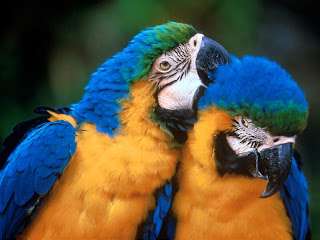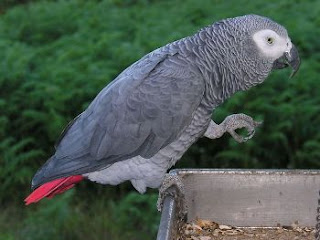Los loros (Psittacidae) poseen un órgano vocal entre la tráquea y los bronquios, denominado siringe, y una lengua carnosa y móvil. Por eso, pueden dar forma al aire y emitir sonidos.
Estas aves no hablan, sino que tienen una gran capacidad para repetir e imitar sonidos, incluso las voces de los humanos.
Son animales muy sociales que viven en bandadas y se comunican permanentemente entre ellos. Hacen sus nidos en los árboles o en los huecos de los barrancos.
Se reúnen en los árboles , apenas se asoman al sol y salen en bandadas a buscar alimentos. A media día, buscan cobijo a la sombra de los árboles menos frondosos.
Poseen un pico muy fuerte y curvo cuya mandíbula superior es articulada y móvil. Pueden utilizar sus patas o su pico indistintamente para trepar.
Las plumas son un indicador de la calidad de vida que tienen, si hay cambios de temperatura bruscos, se les caen con más frecuencia.
Sus patas tienen cuatro dedos: dos están dispuestos hacia delante, y los otras dos, hacia atrás. Los dedos funcionan como resortes que se estiran cuando se aferran a una rama o a una semilla.
Son aves prensoras que pueden aferrarse a las ramas de los árboles con una pata y sostener el alimento con la otra. Las patas de los loros hacen las veces de manos.
Las plumas de la cola son más largas porque sirven de timón durante el vuelo y le dan equilibrio al cuerpo cuando el ave está parada.
Sus ojos son redondos y van cambiando de color a medida que las aves crecen. Les encanta chapotear cuando encuentran agua fresca.
Los yacos o loros grises africanos se han convertido en mascotas exóticas por la facilidad que tienen para aprender a imitar sonidos. Han sido estudiados por la etóloga estadounidense Irene Pepperberg.
La científica puso a prueba la capacidad de aprendizaje de estas aves y llegó a la conclusión de que son muy inteligentes, capaces de aprender y utilizar palabras para identificar objetos, contarlos y clasificarlos.
Parrots (Psittacidae) have a vocal organ between the trachea and bronchi, called syrinx, and a fleshy tongue and mobile. So, can shape the air and make sounds.
These birds do not speak, but they have a great ability to repeat and imitate sounds, including voices of humans.
They are very social animals that live in flocks and communicate to each other constantly. They nest in trees or in holes in the cliffs.
They gather in the trees, just overlook the sun and out in droves to look for food. A half day, seeking shelter in the shade of leafy trees less.
They have a very strong, curved beak whose upper jaw is articulated and movable. They can use their legs or their peak climbing interchangeably.
Feathers are an indicator of the quality of life they have, if temperature changes, they fall more often.
Their feet have four toes, two forward willing, and two backwards. The fingers act as springs that stretch when clinging to a branch or a seed.
Gripping are birds that can cling to the branches of the trees with one leg and hold food with the other. The legs of the birds serve as hands.
The tail feathers are longer because they serve rudder during flight and give balance to the body when the bird is standing.
His eyes are round and change color as the birds grow. They love it when they find cool water splash.
The Greys and African Greys have become exotic pets by the way they can learn to imitate sounds. Have been studied by the American ethologist Irene Pepperberg.
The scientist tested the learning abilities of these birds and concluded that they are very intelligent, able to learn and use words to identify objects, counting and sorting.





No hay comentarios:
Publicar un comentario